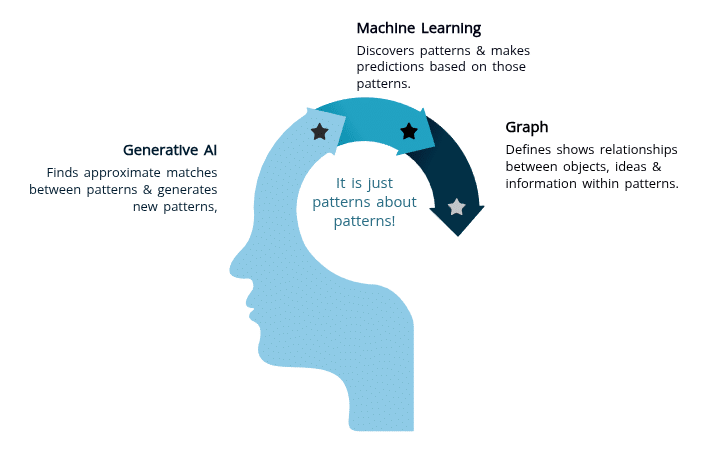Why it Matters
The announcement by Neo4j reflects IBRS’s predicted convergence between graph technologies, machine learning (ML), and GenAI. Graph databases are designed to manage interconnected datasets. They show the connections and allow navigation between information. This capability positions them for applications requiring complex relationship analysis, a key component for robust AI systems, which neither ML (ML) nor GenAI can do.
Rather than viewing the technologies currently referred to as AI as having ‘intelligence’, IBRS strongly recommends thinking of these technologies as ‘pattern services’. Each of the broad technologies touted as AI can then be better understood for its use cases and how they can interact:
Understanding the Three Types of AI
- ML: identifies patterns in complex data, and based on these patterns, makes predictions based on new information. Example: identifies causes and timeframes for asset breakdowns in historic data, then provides preventative maintenance alerts and recommendations.
- Graph: structured patterns of connections (relationships) between information, allowing for navigation (finding links) between highly complex information. For example, link assets, data sheets, manuals, parts availability, locations, maintenance history, skilled staff and contractors, work calendars, and parts, so that a work order can be assembled, including connections with available technicians.
- GenAI: finds patterns that approximately match in the incoming pattern, then iteratively creates a new ‘most likely’ pattern as output. The word approximately is important here: vector and transformer-based GenAI demand a degree of approximation (randomness) to function effectively. This is why they hallucinate. It is essential to recognise that GenAI is not intended to serve as a search engine. It is a pattern replication service. Example: Takes the information from a complex bundle of raw data – such as that provided for the asset management work order – and summarises it into a concise, natural language request and set of instructions.

From the above, you can see how these three ‘pattern services’ work together.
ML is discovery and calls for action, graph is gathering context, and GenAI is making it easy to understand.
Graph is the Missing Piece of the Puzzle
A major reason why GenAI projects – and the closely related agentic AI programs – have failed to deliver the efficiency gains is that the context gathering phase has been weak. While RAG (retrieval augmented generation) does help, most approaches still rely on GenAI to perform the search. This is also the problem with ‘reasoning’ in agentic systems, which is really just GenAI creating a series of prompts iteratively, with each step in the reasoning being susceptible to hallucinations.
Graph, on the other hand, does not suffer from hallucinations. It is specifically engineered to link information assets. Thus, it can be highly effective in collecting related information packages for a wide variety of activities, and is far more accurate, complete and less costly than running ever bigger GenAI models and agents.
Graphic is already making inroads into RAG, but its use in agentic AI orchestration will be significant.
IBRS Prediction on AI
IBRS has previously predicted that graph services will see rapid uptake in late 2026-2027 due to the increasing simplification of creating graph databases and the realisation that they are essential to making generative and agentic AI effective in automation.
The trend is: growing uptake of graph database within AI orchestration, coupled with a shift to smaller, specialised ML and GenAI models for most ‘business automation’. Over time, these pattern services will become integral components of business process automation. It is at this time that we will see the deeper efficiency gains promised by AI.
Neo4j’s investment in GenAI is telling. While they are currently leaders in graph technology, hyperscale vendors are rapidly deploying their own platforms. Neo4j is banking on the fact that simply having the ‘best’ graph will not be enough. It is the combination of ML and GenAI that will be the future.
Who’s Impacted?
- CIOs and CTOs: They should evaluate the potential of integrated graph and GenAI solutions for enhancing data-driven decision-making and developing intelligent applications. This includes assessing the infrastructure requirements and scalability of such systems.
- Data Scientists and AI Teams: These teams will identify new tools for building and deploying AI agents that utilise graph capabilities relevant to their needs. The offerings aim to address challenges in grounding AI models with enterprise data and ensuring explainability.
- Enterprise Architects: They need to consider how graph databases and agentic AI systems fit into their existing data architecture, particularly for managing complex, interconnected data and facilitating advanced analytics.
- Business Unit Leaders: Leaders in areas such as customer service, fraud detection, and supply chain management could explore how agentic AI, supported by graph technology, might automate processes and provide deeper insights.
- Software Developers: Developers working on AI-driven applications may benefit from simplified frameworks for integrating contextual reasoning and persistent memory into their solutions.
Next Steps
- Organisations should conduct a thorough assessment of their current data infrastructure to determine its suitability for supporting advanced graph and GenAI applications.
- Evaluate the practical applications of graph databases in conjunction with GenAI for specific business challenges, focusing on areas where interconnected data and contextual understanding are critical.
- Explore proof-of-concept projects using available graph and GenAI tools to understand their efficacy in real-world scenarios.
- Consider the skills gap within internal teams related to graph technology and AI, planning for necessary training or recruitment to support adoption.
- Investigate vendor offerings in the graph database and GenAI space, comparing features, scalability, and integration capabilities with existing systems.


